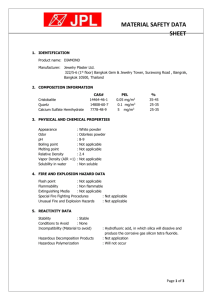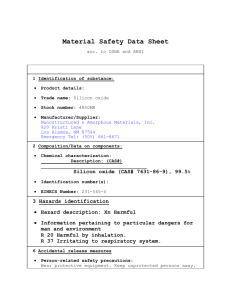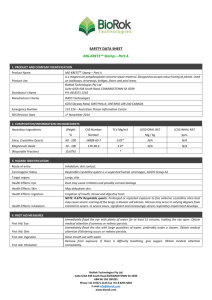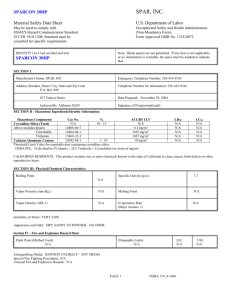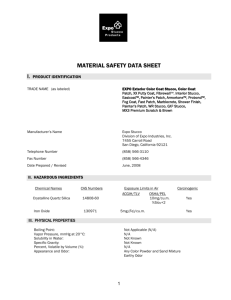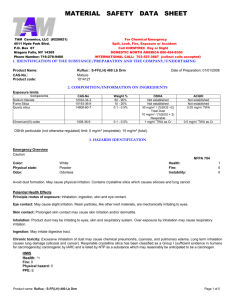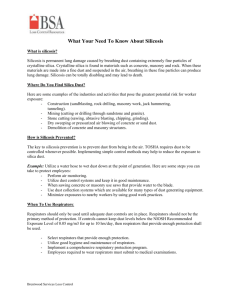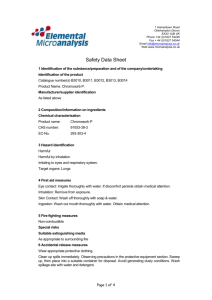UNIVERSITY OF CINCINNATI Environmental University Health Services 556-4968
advertisement
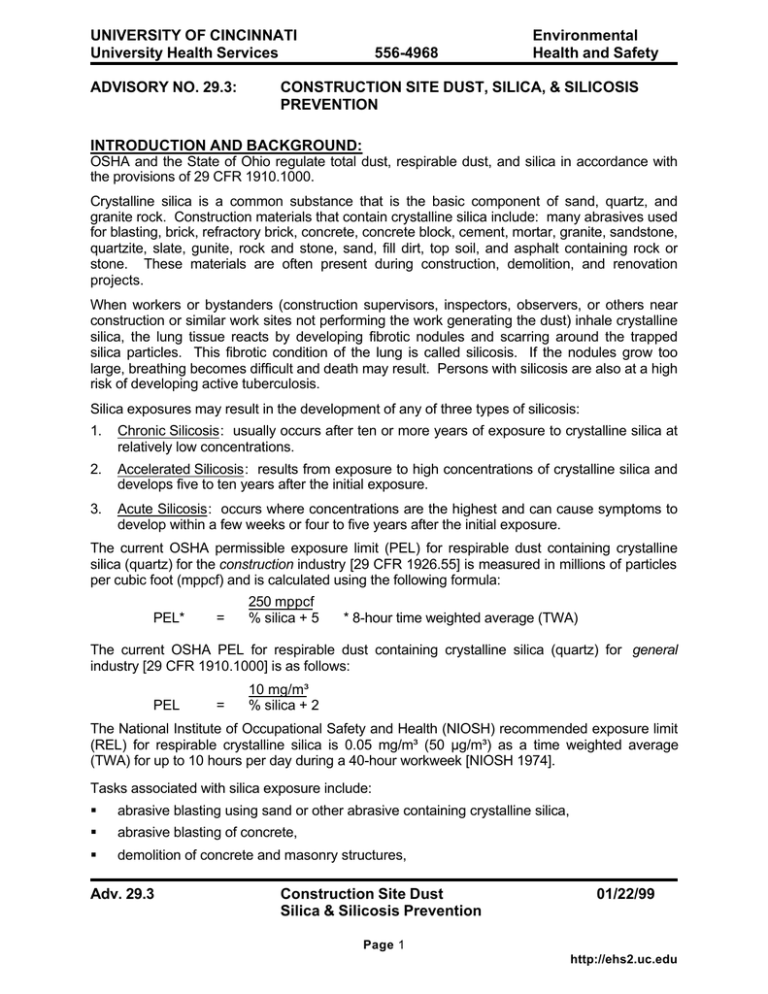
UNIVERSITY OF CINCINNATI University Health Services ADVISORY NO. 29.3: 556-4968 Environmental Health and Safety CONSTRUCTION SITE DUST, SILICA, & SILICOSIS PREVENTION INTRODUCTION AND BACKGROUND: OSHA and the State of Ohio regulate total dust, respirable dust, and silica in accordance with the provisions of 29 CFR 1910.1000. Crystalline silica is a common substance that is the basic component of sand, quartz, and granite rock. Construction materials that contain crystalline silica include: many abrasives used for blasting, brick, refractory brick, concrete, concrete block, cement, mortar, granite, sandstone, quartzite, slate, gunite, rock and stone, sand, fill dirt, top soil, and asphalt containing rock or stone. These materials are often present during construction, demolition, and renovation projects. When workers or bystanders (construction supervisors, inspectors, observers, or others near construction or similar work sites not performing the work generating the dust) inhale crystalline silica, the lung tissue reacts by developing fibrotic nodules and scarring around the trapped silica particles. This fibrotic condition of the lung is called silicosis. If the nodules grow too large, breathing becomes difficult and death may result. Persons with silicosis are also at a high risk of developing active tuberculosis. Silica exposures may result in the development of any of three types of silicosis: 1. Chronic Silicosis: usually occurs after ten or more years of exposure to crystalline silica at relatively low concentrations. 2. Accelerated Silicosis: results from exposure to high concentrations of crystalline silica and develops five to ten years after the initial exposure. 3. Acute Silicosis: occurs where concentrations are the highest and can cause symptoms to develop within a few weeks or four to five years after the initial exposure. The current OSHA permissible exposure limit (PEL) for respirable dust containing crystalline silica (quartz) for the construction industry [29 CFR 1926.55] is measured in millions of particles per cubic foot (mppcf) and is calculated using the following formula: PEL* = 250 mppcf % silica + 5 * 8-hour time weighted average (TWA) The current OSHA PEL for respirable dust containing crystalline silica (quartz) for general industry [29 CFR 1910.1000] is as follows: PEL = 10 mg/m³ % silica + 2 The National Institute of Occupational Safety and Health (NIOSH) recommended exposure limit (REL) for respirable crystalline silica is 0.05 mg/m³ (50 µg/m³) as a time weighted average (TWA) for up to 10 hours per day during a 40-hour workweek [NIOSH 1974]. Tasks associated with silica exposure include: § abrasive blasting using sand or other abrasive containing crystalline silica, § abrasive blasting of concrete, § demolition of concrete and masonry structures, Adv. 29.3 Construction Site Dust Silica & Silicosis Prevention 01/22/99 Page 1 http://ehs2.uc.edu UNIVERSITY OF CINCINNATI University Health Services 556-4968 Environmental Health and Safety § chipping, cutting, sawing, grinding, drilling, jack hammering of concrete, masonry, or mortar § dry sweeping or pressurized air blowing of concrete, rock, or sand dust. Trades at risk to silica exposure include: abrasive blasters, masonry workers, drillers, rock crusher, cement mixer, laborer, operating engineer, painter, plasterer, plumber, and truck driver. Bystander exposure can also occur when others are in or near construction, demolition, or renovation areas where materials containing crystalline silica are present and no efforts have been made to reduce or contain the hazard. PREVENTIVE MEASURES: The National Institute of Occupational Safety and Health (NIOSH) recommends the following measures to reduce worker and bystander exposures to respirable crystalline silica in the workplace and to prevent silicosis and deaths among construction workers: 1. Recognize when silica dust may be generated and plan ahead to eliminate or control the dust at the source. Awareness and planning are keys to the prevention of silicosis. 2. Do not use silica sand or other substances containing more than 1% crystalline silica as abrasive blasting materials. Substitute less hazardous materials. 3. Use engineering controls and containment methods such as blast cleaning machines and cabinets, wet drilling, or wet sawing of silica-containing materials to control the hazard and protect workers from exposure. 4. Routinely maintain dust control systems to keep them in good working order. 5. Practice good personal hygiene to avoid unnecessary exposure to other worksite contaminants such as lead. 6. Wear disposable or washable protective clothes at the worksite. 7. Shower (if possible) and change into clean clothes before leaving the worksite to prevent contamination of cars, homes, and other work areas. 8. Conduct air monitoring to measure worker exposures and ensure that controls are providing adequate protection of workers (and bystanders). 9. Use adequate respiratory protection when source controls cannot keep silica exposures below the NIOSH Recommended Exposure Limit (REL). 10. Provide periodic medical examinations for all workers who may be exposed to respirable crystalline silica. 11. Post warning signs to mark the boundaries of work areas contaminated with respirable crystalline silica. 12. Provide workers with training that includes information about health effects, work practices, and protective equipment for respirable crystalline silica. 13. Report all cases of silicosis to State health departments and OSHA. The key to preventing silicosis is to keep dust out of the air. Dust controls can be as simple as a water hose to wet the source before dust becomes airborne. Use the following methods to control respirable crystalline silica: § Use dust collection systems available for many types of dust-generating equipment. § Use local exhaust ventilation to prevent dust from being released into the air. Adv. 29.3 Construction Site Dust Silica & Silicosis Prevention 01/22/99 Page 2 http://ehs2.uc.edu UNIVERSITY OF CINCINNATI University Health Services 556-4968 Environmental Health and Safety § Always use the dust-control system and keep it well maintained; do not use the equipment if the control system is not working properly. § When sawing concrete or masonry, use saws that provide water to the blade. § Use good work practices to minimize exposures and to prevent nearby workers from being exposed. § Remove dust from surfaces with a water hose rather than with compressed air, or use vacuums with high efficiency particulate (HEPA) filters, or use wet sweeping instead of dry sweeping. § Use containment methods to prevent dust from being released into a wider area. UNIVERSITY RESPONSIBILITIES: The Construction Management project manager can contact Environmental Health & Safety at 556-4968 to obtain hazard communication information for outside contractors on projects. Preconstruction meetings should occur which address engineering controls for areas occupied by University of Cincinnati employees and/or students, and for the control of emissions into the environment. University operations and maintenance personnel are required to utilize engineering controls for areas occupied by University employees and/or students, and for the control of emissions into the environment. Contact Environmental Health & Safety at 556-4968 for information as required. INFORMATION RESOURCES: Additional information is available in NIOSH Publication No. 96-112, Preventing Silicosis and Deaths in Construction Workers, or via the Internet at: www.cdc.gov/niosh/consilic.html Other Internet sources include: www.cdc.gov.niosh/silfact1.html www.cdc.gov/niosh/silicpag.html www.cpwr.com/ Adv. 29.3 Construction Site Dust Silica & Silicosis Prevention 01/22/99 Page 3 http://ehs2.uc.edu
